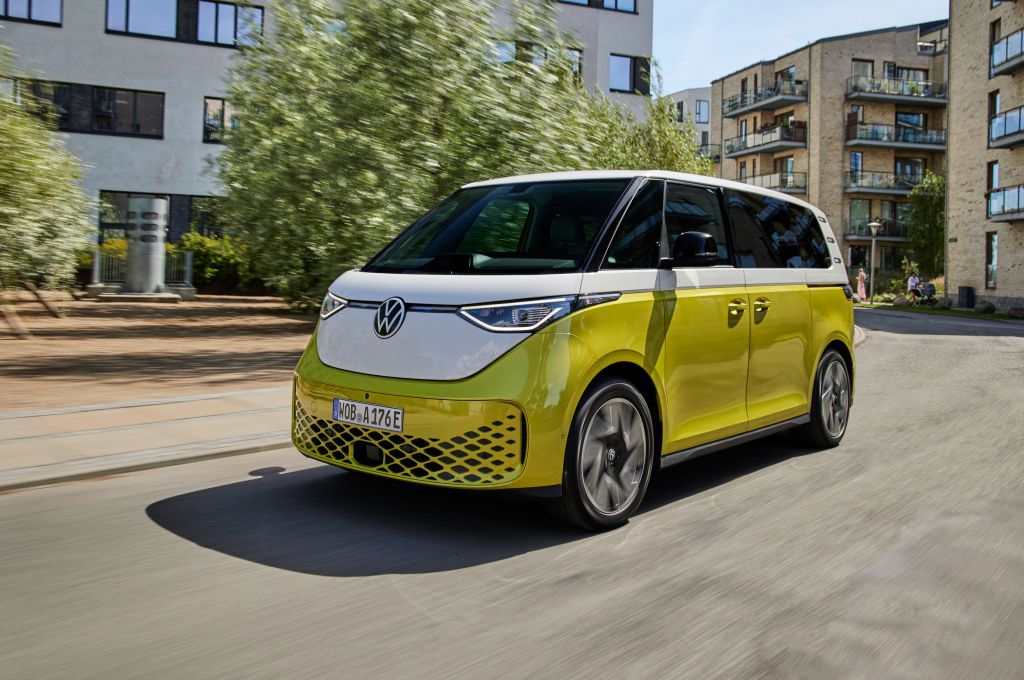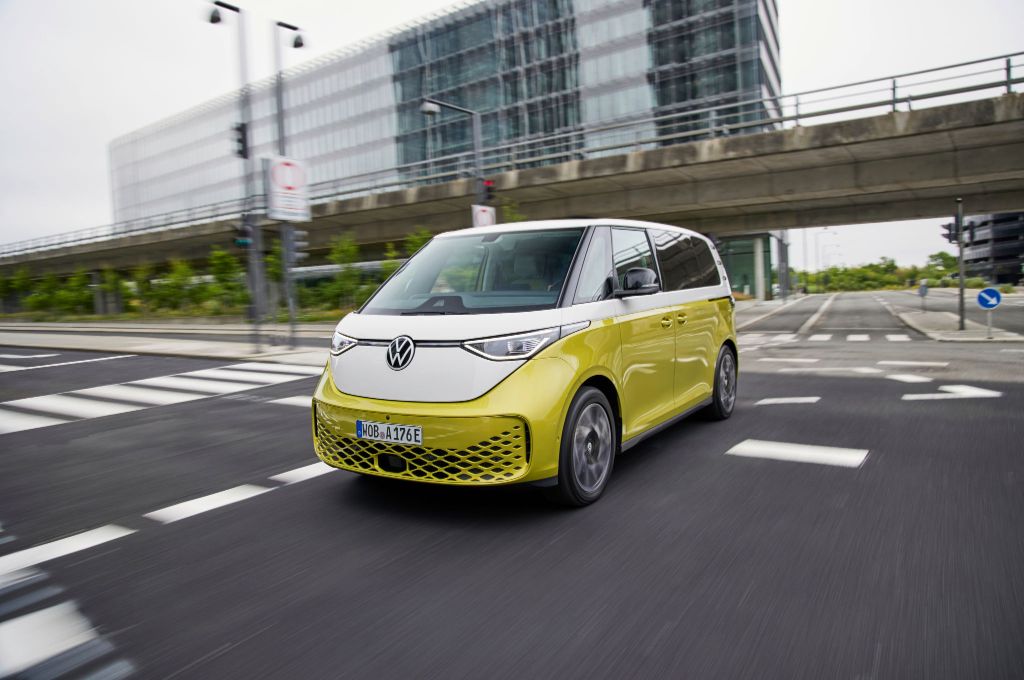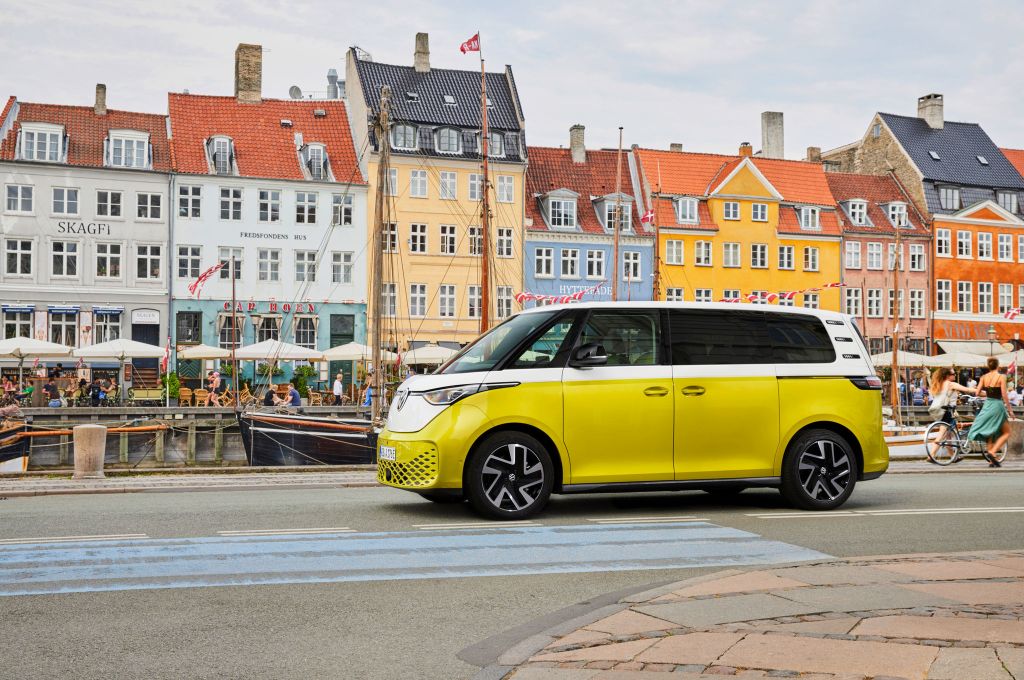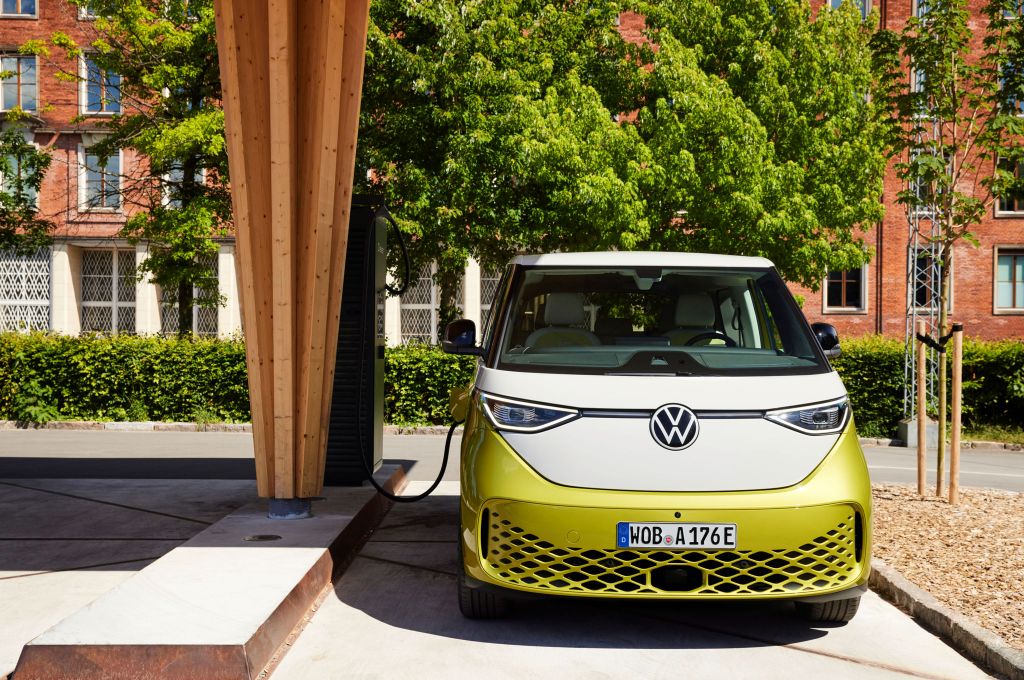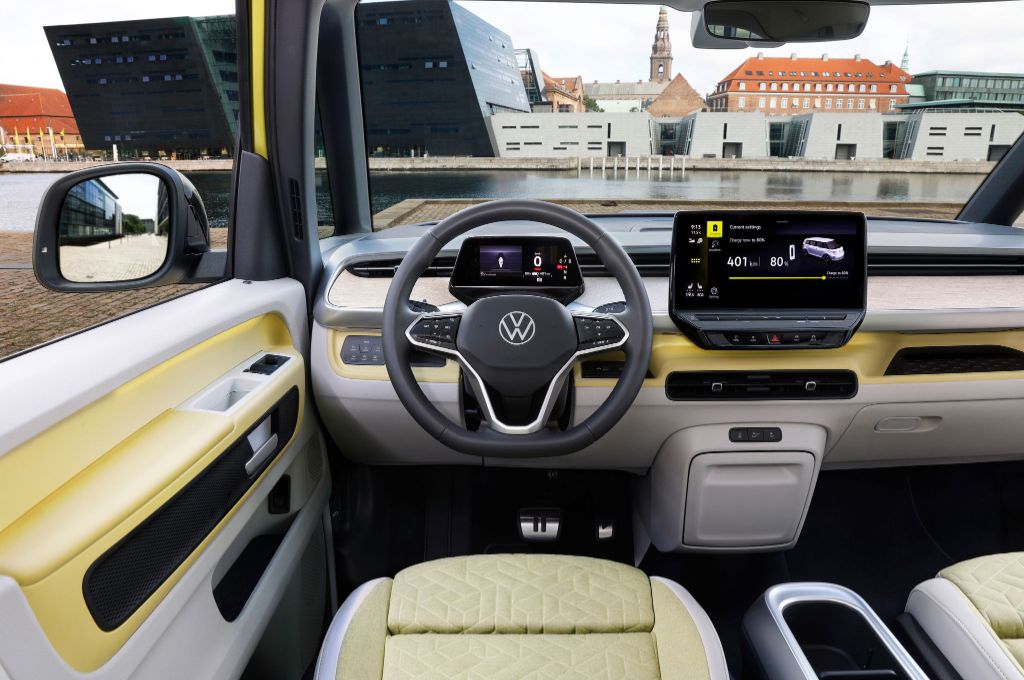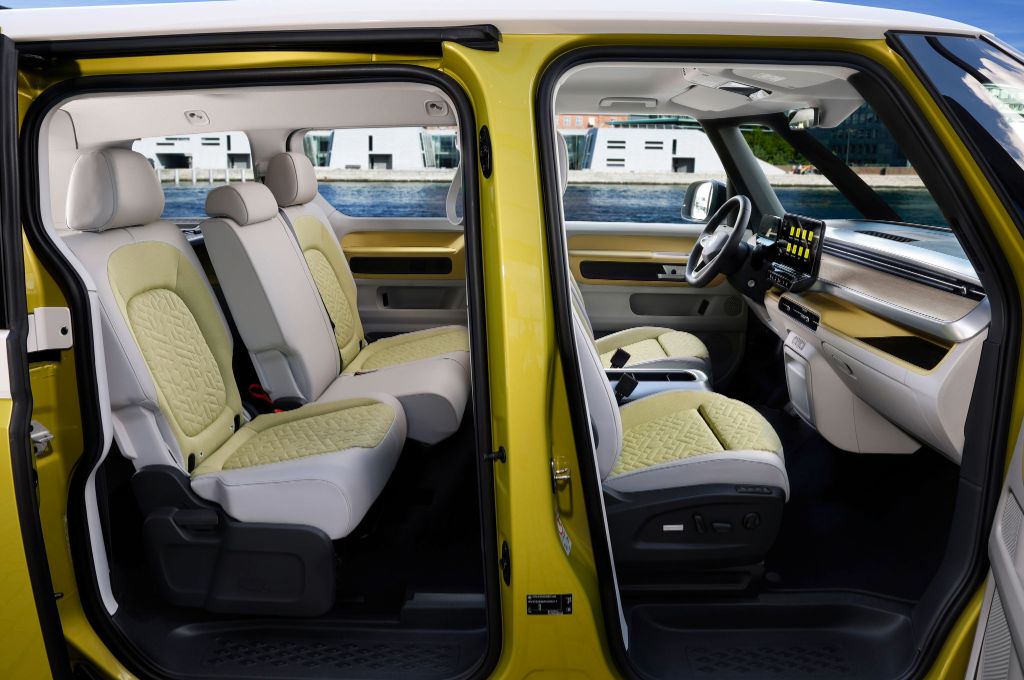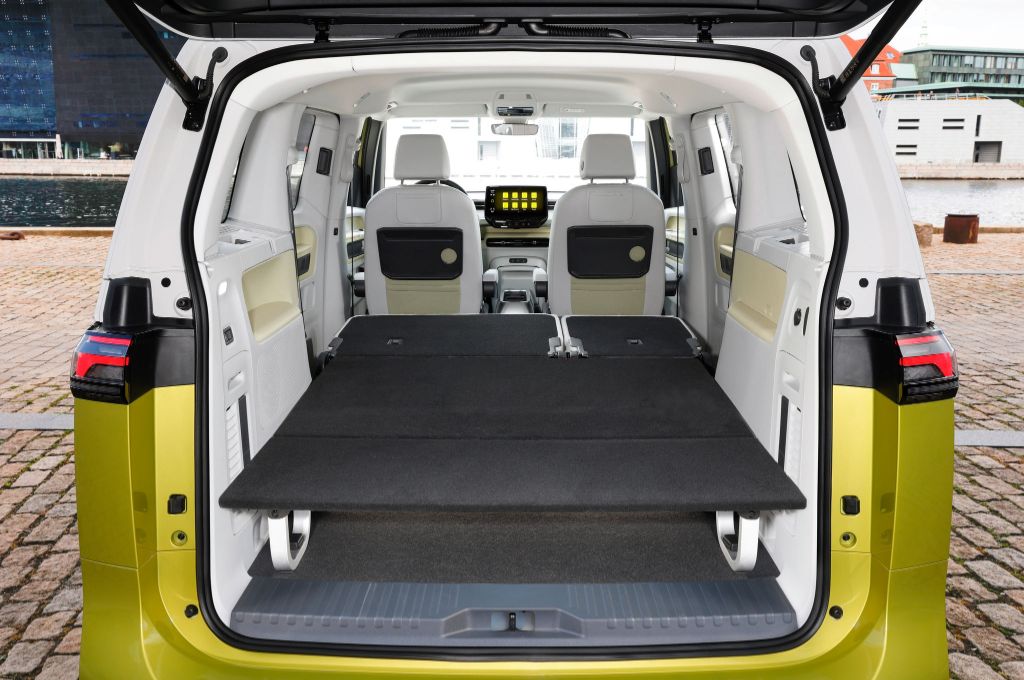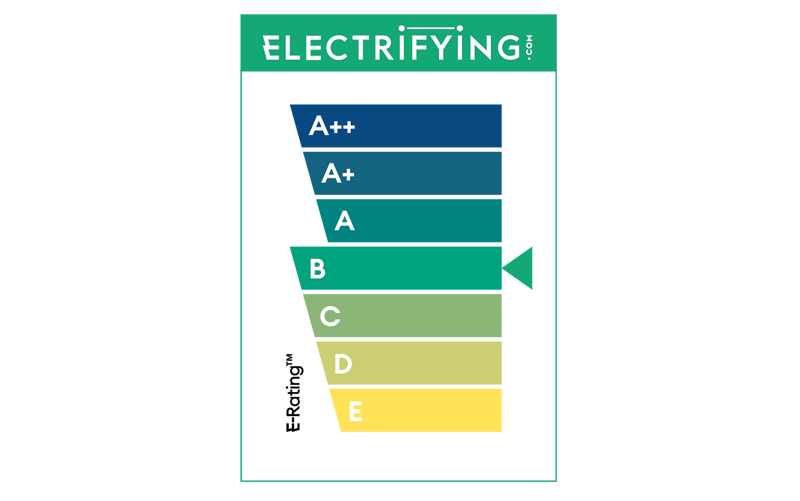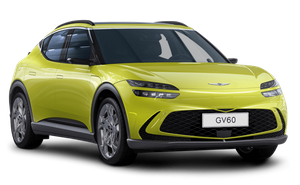First, a bit of background. The ID. Buzz first appeared in 2017 as a concept show car, complete with its own levitating gnome on the dashboard, among other daft features. At the time, Volkswagen said that a production version was in the pipeline and would be a key model in the ID range. However, even most optimistic of observers doubted whether the Buzz would make the transition from concept to reality without a significant watering-down of the design.
Thankfully, the doubters were wrong. In the metal, the ID. Buzz is a glorious piece of design. Yes, there are some elements that have been compromised to ensure compliance with crash regulations and the like, but the final production ID. Buzz is impressively close to the concept - especially in the fabulous two-tone yellow paint option.
The five-seater and van launch models are the first of numerous planned variants that will eventually form an ID. Buzz range. Seven seater and longer wheelbase models are in the product plan, along with the version everybody wants (but few will be able to afford): the ID. Buzz California camper van.
ID. Buzz design
The ID. Buzz is based on the same foundations as all the Volkswagen Group ID models. Known as the MEB platform, this is effectively a giant skateboard with the wheels, suspension and motors at one end and the battery pack in the middle. To help ensure that the platform doesn’t compromise the design of the cars on which they are based, Volkswagen engineers can tweak the wheelbase (the distance between the wheels from front to rear). As a result, the ID. Buzz has a longer wheelbase (2,989mm vs 2,771mm) than the ID.4. That, along with a much higher roofline, means that the Buzz feels much bigger than its SUV stablemate inside. The floor is also much higher in the Buzz and features a small step up into the cabin. Although you get used to it after a while, it serves as a constant reminder that you’re driving a machine with commercial vehicle roots.
At the front, LED headlights wrap around into the bodywork to give an art-deco look while the signature front light strip runs between the headlights and through the big VW badge. Then there’s a full-width grille at the bottom beneath the badge which includes a slightly awkward-looking sensor for the radar cruise control and other automated driving functions.
The front doors are hinged as normal, while the rear has sliding doors either side. This makes it handy for loading kids or tight car parking spaces - with a car this size, that’s going to be a real bonus. The sliding doors are, however, quite heavy, so unless you enjoy weight lifting, you’ll need to specify Volkswagen’s Open and Close option package which comes in at a hefty £1,055.
At the rear, there’s a vast single-piece tailgate that gives great access to the very big and very square load area. The only thing to note is that the size of the tailgate is such that you need quite a bit of space behind the car to open it fully. If you squeeze into a parking bay in the street, don’t be surprised if you can’t swing the back door fully open.
In terms of boot space, the ID. Buzz offers an incredible 1,121 litres of space with the rear seats in position. Fold the second row down and that figure rises to 2,205 litres – comfortably more than any rival models can muster. What’s more, the rear seats fold to give a completely flat load area – or a makeshift bed if you’re too tight to shell out for a B&B. And, at 2.2 metres from front seat back to tailgate, a six-footer will even be able to lie full-length.
The seats themselves are comfortable, well-shaped and help deliver a fine driving position while the vast glass area gives passengers a fabulous view of their surroundings. The Buzz feels like a car that can cover vast distances with effortless ease – whether you’re up front or in the back. The only slight fly in the ointment is that the ID. Buzz really only offers four decently shaped seats. While it can officially carry five, the fifth passenger will have to make do with the middle hump seat – which isn’t exactly comfortable on longer hauls.
The dashboard stretches out in front of the cab and despite covering a huge area, is cleverly detailed and neatly laid-out. Opt for the entry-level Life model and the dash area, steering wheel and infotainment frame is finished in black and grey. Move up to the Style version and the whole cabin, including the seats, is colour-matched to the exterior. Style buyers also gain a white steering wheel and a white frame for the infotainment system, which some will love and others will find themselves constantly cleaning.
Some – especially those who sampled early versions of it – may also be a bit wary about the appearance of the same infotainment system that appears on the ID.3 and ID.4. Thankfully, the whole system is a lot slicker than it was (which isn’t difficult), but it’s far from being the finished article. It still takes a long time to boot up and switching between screens still comes with a lag. Interestingly, Volkswagen has ditched the BMW i3-style rotating gear selector on the dashboard screen housing in favour of a more traditional twist lever attached to the steering column.
ID. Buzz driving
Thanks to its MEB foundations – it shares its underpinnings with the ID.3 and ID.4 – the ID. Buzz delivers a smooth and refined driving experience. The ride quality, even on the optional 21-inch Bromberg alloy wheels is composed over small bumps and equally adept at smoothing out bigger undulations. The steering is pleasantly weighted and Volkswagen’s engineers need to be congratulated for giving the ID Buzz a turning circle of just 11.1 metres. It might sound like a relatively meaningless stat, but given its length and width, the fact that it can out manoeuvre much smaller cars in tight spaces is a real bonus.
For electric car owners used to hearing about new models with sub-five seconds 0-62mph times, the ID. Buzz with its 10.2 seconds benchmark might sound like something of a pudding. However, once behind the wheel, that figure feels somewhat misleading. Acceleration from rest is lively and there’s a useful shove of torque if you need to make any overtaking manoeuvres. While the ID.4 is quicker on paper (0-62mph in 8.5 seconds), the ID. Buzz feels just as rapid and agile.
Like other ID. models, the Buzz comes with a rather gentle regen system that will feel almost non-existent to drivers who have sampled a more focussed one-pedal driving setting. Activated by selecting ‘B’ on the gearshifter, it feels barely noticeable at higher speeds and would benefit from being more powerful at urban speeds. Using the brakes, even on modest downhill sections, feels like a waste of energy that could otherwise be fed back into the battery pack.
Thankfully, the friction brakes are more than up the task. Although the ID. Buzz tips the scales at a porky 2,459kg and has drums at the rear, the braking system feels powerful and can bring the Buzz to a halt with impressive speed.
Should you fancy a spot of towing, the Buzz can be specified with a retractable tow bar that can handle up to 1,000kg.
ID. Buzz battery, range and charging
The ID. Buzz launches with a single 77kWh battery pack and features a 201bhp motor that drives the back wheels. It’s mechanically identical to the set-up you’ll find in an ID.4, ŠKODA Enyaq and Cupra Born. However, the ID. Buzz is the first of Volkswagen’s ID models to come with a 170kW rapid charging speed. Although all 77kWh models in the range will be able to charge at this higher rate, the Buzz is the first to benefit from the speed increase.
In reality, it means that a charge from 10-80% will take around 30 minutes when hooked up to a 170kW+ rapid charger. The ID. Buzz comes with an 11kW AC charger even though most domestic users will only be able to draw 7kW from a home wallbox.
In terms of range and consumption, the ID. Buzz is good but not great. Although the ID.4 enjoys a WLTP range figure of well over 300 miles, the Buzz’s official figure is just 254 miles (ID. Buzz Style). However, based on our test route, the ID. Buzz appears to be kinder on its battery than the figures suggest. Although our routes were largely A-roads and urban areas, we averaged around 3.3 miles per kWh. That would give a theoretical range of just over 250 miles, which is about the same ‘real world’ figure as we’ve achieved in an ID.4.
To balance that, our drive was carried out at 21 degrees and featured a relatively short section of motorway. We’d suspect that the combination of British winter temperatures and some longer 70mph runs will see that miles per kWh duck down to around the 3.0 mark.
ID. Buzz UK range and pricing
The ID. Buzz will be available with two trim levels, Life and Style. The entry-level Life starts at £57,115 and comes with LED headlights, heated windscreen, the Buzz box removable storage, Discover Pro navigation and infotainment with 10-inch colour touchscreen, and wireless charging. Style, priced from £61,915 adds VW’s’IQ. Light’ LED matrix headlights, adaptive interior ambient lighting and tailgate surround lighting. Style models also benefit from a colour-matched interior.












